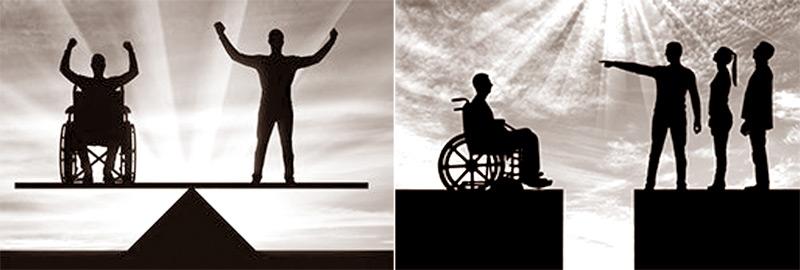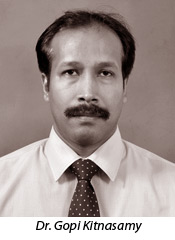
December 3 brought together a host of experts on the wide ranging issues causing disability which today is one of the leading causes of morbidity and mortality among young and old alike. As elsewhere the numbers are steadily spiralling in Sri Lanka calling for urgent interventional measures to prevent unnecessary loss of limbs and lives from preventable injuries.
The Sunday Observer spoke to Head of Rehabilitation Services, MJF Charitable Foundation, Dr. Gopi Kitnasamy, an expert in the field especially with disability in young children to find out what interventional measures should be adopted to halt this worrying health trend.
Excerpts
 Q. Disability took centre stage last week when the world observed International Disability Day on December 3. Why has a special day been set aside for observing this day?
Q. Disability took centre stage last week when the world observed International Disability Day on December 3. Why has a special day been set aside for observing this day?
A. The International Day of Disabled Persons is observed on December 3 annually. This was proclaimed by the United Nations General Assembly in 1992. This is observed to promote an understanding of disability issues and mobilise support for the dignity, rights, and well-being of persons with disabilities. This also increases awareness of the importance of empowering and integrating persons with disabilities in every aspect of political, social, economic, and cultural life.
Q. Define Disability. Are there different types of disability?
A. Disability is a physical or a mental condition that makes it difficult for someone to do the things that other people do. It can be visible or invisible. Today, disability is understood to arise from the interaction between a person’s health condition or impairment and the multitude of influencing factors in their environment. Disability can happen to anyone at any age. There are many types of disabilities that affect a person’s vision, movement, thinking, remembering, learning, communicating, hearing, mental health and social relationships. Disability in childhood can have a lifelong impact on a person’s physical, mental and emotional health, as well as their social situation. Children with a disability may have special needs, particularly regarding health and education, and may need to negotiate significant social and environmental barriers to fully participate in everyday life.
Q. The theme for International Disability Day this year was ‘Transformative solutions for inclusive development: the role of innovation in fuelling an accessible and equitable world’.”. What is its significance to the disabled in Sri Lanka?
A. Lack of accessibility is the key reason for marginalisation of persons with disability. This leads to less opportunities, reduced participation and causes inequality in the society. In Sri Lanka, the lack of accessibility to transport services, education, job opportunities and also health services are huge challenges for the persons with disabilities and their families.
This is very obvious during crises like the recent pandemic. These challenges and barriers are an additional burden to PWDs and their families and can lead to poverty, malnutrition and morbidity.
Q. What are the current statistics on persons living with disabilities globally ?
A. Over one billion people are estimated to live with some form of disability which is about 15% of the world’s population.
Q. Do you see this number increasing in the near future? Why? Who are likely to be the most vulnerable communities affected?
A. As I see it, this number will increase for several reasons: population growth ( the global population has now peaked), ageing process and increase in chronic health conditions. Other factors like road traffic accidents, violence and disasters which are now on the rise, also contribute to the growing numbers. Eighty percent of them are living in developing countries.
Q. Any data on the estimated number of disabled persons in Sri Lanka at present?
A. As per the 2012 population census, there are 1.6 million persons with disabilities in Sri Lanka which is 8 percent of our population. I will say that this figure is not the exact statistics, as this didn’t cover all types of disabilities and not all persons with disabilities were included. Detailed and accurate data collection can provide a wealth of information and exact statistics of persons with disabilities in Sri Lanka.
Q. It is said that there are around 21 types of disabilities that affect a person’s normal physical and mental abilities. Which of them is most common both globally and in Sri Lanka?
 A. Physical disability is the most common type globally as well as in Sri Lanka. Physical disability results in the person having a reduced ability, or inability, to perform body movements such as walking, moving their hands and arms, sitting, and standing as well as controlling their muscles. It is not about the physical condition itself but how it impacts daily life, such as the ability to carry out work activities. A person may be born with a physical disability or acquire it in life due to an accident, injury, illness or as a side effect of a medical condition.
A. Physical disability is the most common type globally as well as in Sri Lanka. Physical disability results in the person having a reduced ability, or inability, to perform body movements such as walking, moving their hands and arms, sitting, and standing as well as controlling their muscles. It is not about the physical condition itself but how it impacts daily life, such as the ability to carry out work activities. A person may be born with a physical disability or acquire it in life due to an accident, injury, illness or as a side effect of a medical condition.
Q. What are the leading causes for physical disability?
A. Disability has many causative factors. They include heredity, birth defects, lack of care during pregnancy and childbirth, congenital diseases, malnutrition, natural disasters, traffic accidents, war, violence, work-related accidents and illnesses and sports accidents. In addition there are communicable and non-communicable diseases, drugs, alcohol, smoking, toxic chemicals, and mental health problems that also drive the disease.
Q. What about premature birth during pregnancy? Are such children vulnerable to some form of disability as well both mentally and physically?
A. Yes. Low birthweight, premature birth, multiple birth, and infections during pregnancy are associated with an increased risk for many developmental disabilities.
Q. Recent research has proved that poverty which we are now experiencing in Sri Lanka right now with the cost of living making it difficult for people to afford even one meal a day, let alone their essential medications, is one of the biggest causes for disability today. Do you agree?
A. Certainly. Poverty is one of the biggest causes of disability. Poor people are most vulnerable to disability because they are forced to live and work in unsafe environments with poor sanitation, crowded living conditions and with little access to education, clean water, or enough good food.
Q. Who are at risk of developing these disabilities age and gender-wise ? Young? Elderly? Why?
A. More than 46 percent of older persons, those aged 60 years and over have some form of disabilities. The contributing risk factors are age-related diseases, impairments, functional limitations, poor coping strategies, sedentary lifestyles and other unhealthy behaviour, as well as social and environmental obstacles. The World Health Survey estimates give a female prevalence of disability nearly 60 percent higher than that for males. Greater prevalence of nonfatal disabling conditions, including fractures, osteoporosis, back problems, osteoarthritis and depression, contributes substantially to greater disability and diminished quality of life among aging women compared with men.
Q. Cerebral Palsy (CP) is said to be the most common physical disability in children. What is it?
A. It is a neurological disorder caused by a non-progressive brain injury or malformation that occurs while the child’s brain is still developing. There is no single cause for Cerebral Palsy and at present, no new scientifically proven method has been found to totally prevent or cure cerebral palsy.
Q. How do you identify a child having CP? What are the signs?
A. The most common early signs of cerebral palsy are developmental delays in reaching key growth milestones, such as rolling over, crawling, sitting, and walking.
While lifting or carrying, there can be variations in muscle tone, such as being either too stiff or too floppy. Sucking and feeding difficulties, difficulty in holding the head upright, excessive crying, lack of attention, favoring one hand over the other or stiffness on the other side are the other common signs.
Q. Who are most at risk of developing this condition? Why?
A. Premature babies, multiple births, infection during pregnancy, mothers with medical conditions, complicated deliveries, severe jaundice and seizures in infants are some of the factors that may increase a baby’s risk of being born with cerebral palsy.
Q. What is the best approach to rehabilitate children with severe disabilities?
A. A family-centered or focused approach is considered the best practice in Paediatric rehabilitation. This approach recognises that each family is unique, is the constant in a child’s life, and that parents are the experts on a child’s abilities and needs. As a parent of a child with CP, I have always emphasized the importance of this approach and have seen better progress with these children when the parents are part of the rehabilitation process.
Q. Tell us about the services provided by the MJF Charitable foundation and how the families with these children can get benefitted?
A. As our approaches are child and family-centered which focuses on improving their functional abilities and thereby their quality of life, we are seeing very good improvements in their conditions. We also have introduced early identification and early intervention program for infants as the first five years of life is very critical and the brain’s response is much better.
Q. What are the other initiatives taken by the MJF Foundation to help these children and their families?
A. Our initiatives to improve the lives of individuals with CP and other developmental disorders and their families includes provision of special education and therapy services, trainings and awareness programs for the general public as well as educators and professionals who want to update their knowledge, advocacy for individuals with CP and providing wheelchairs and other mobility devices around the country for children & adults with physical disabilities and also to the rehab units of the government hospitals. We have also started Vocational Training for youth and adults with special needs.
During the Covid-19 lockdown, the foundation launched the Disability YouTube channel (the first trilingual channel on Disability) and the Disability Screening app (the first tele-screening and therapy platform in Sri Lanka) to share knowledge, therapies, and services for people with disability especially children in regions of Sri Lanka where access to transport, regular therapy and other services are limited.
The app includes guided disability and development screening, referral services to connect them with Paediatricians and other experts, early identification, and intervention, and tele-therapeutic, educational, and rehabilitation assistance, allowing caregivers to monitor progress with the guidance from MJF Charitable Foundation’s multidisciplinary team. The app is available for both android and I-phones and is available free to download on the Google Play and App Stores.
Q. Your message to our readers who are caring for a disabled child?
A. Although education is a fundamental right of children, 90 percent of children with disabilities in developing countries do not attend school. Education empowers a child.
Education gives the children with disabilities skills to allow them to become positive role models and join the employment market, thereby helping to prevent poverty. Hence parents and caregivers of all disabled children must do their best to impart the importance and value of education as an empowering tool to their children.
